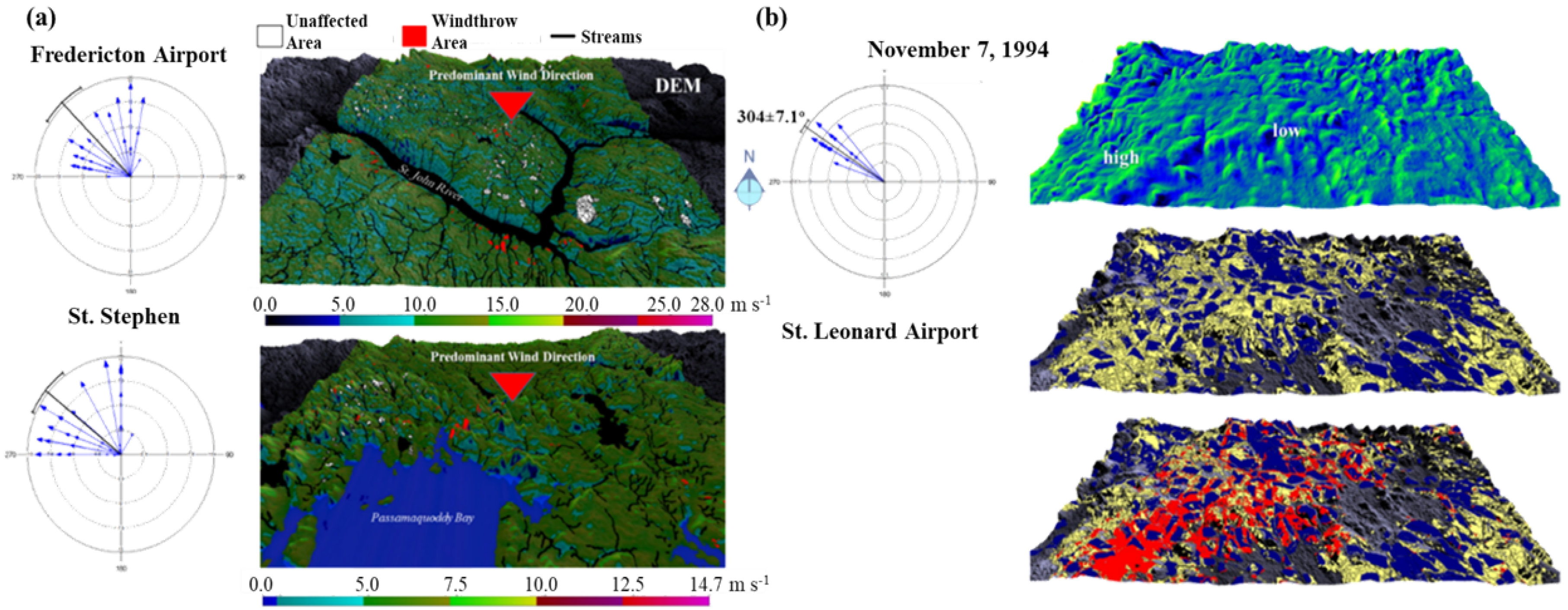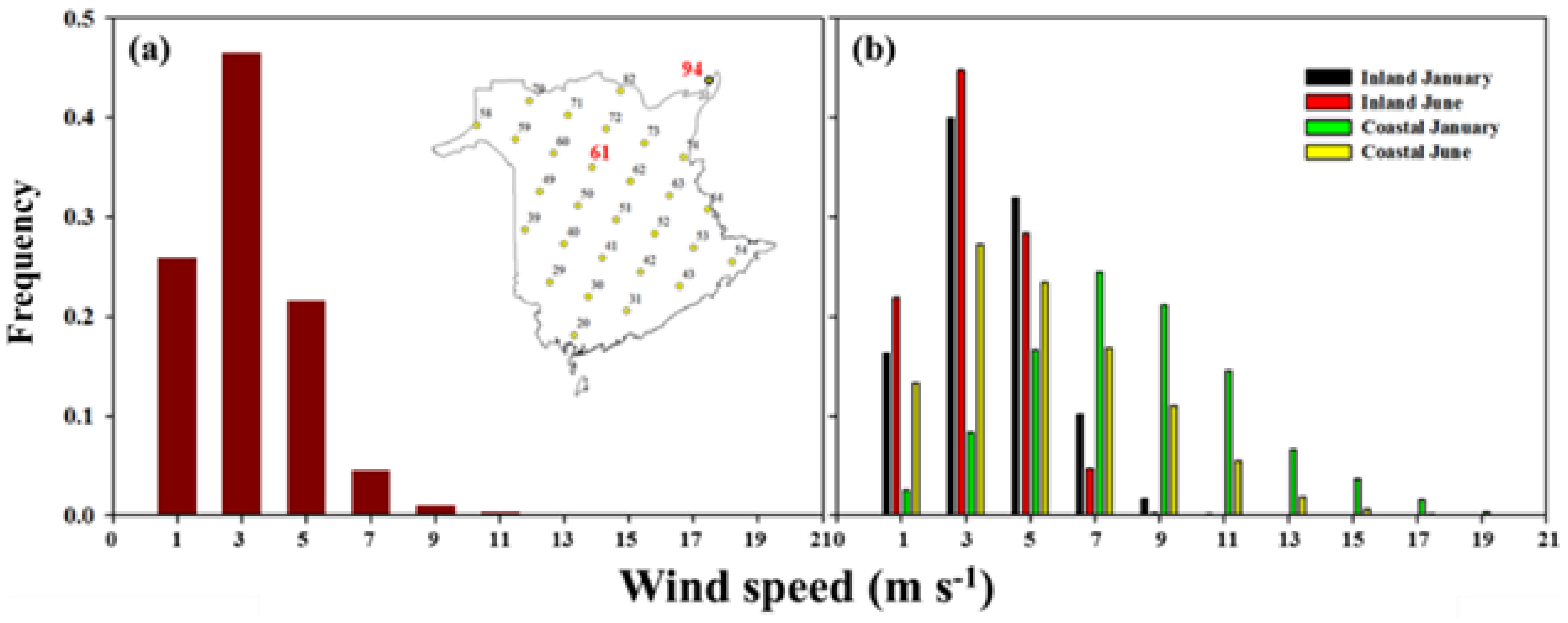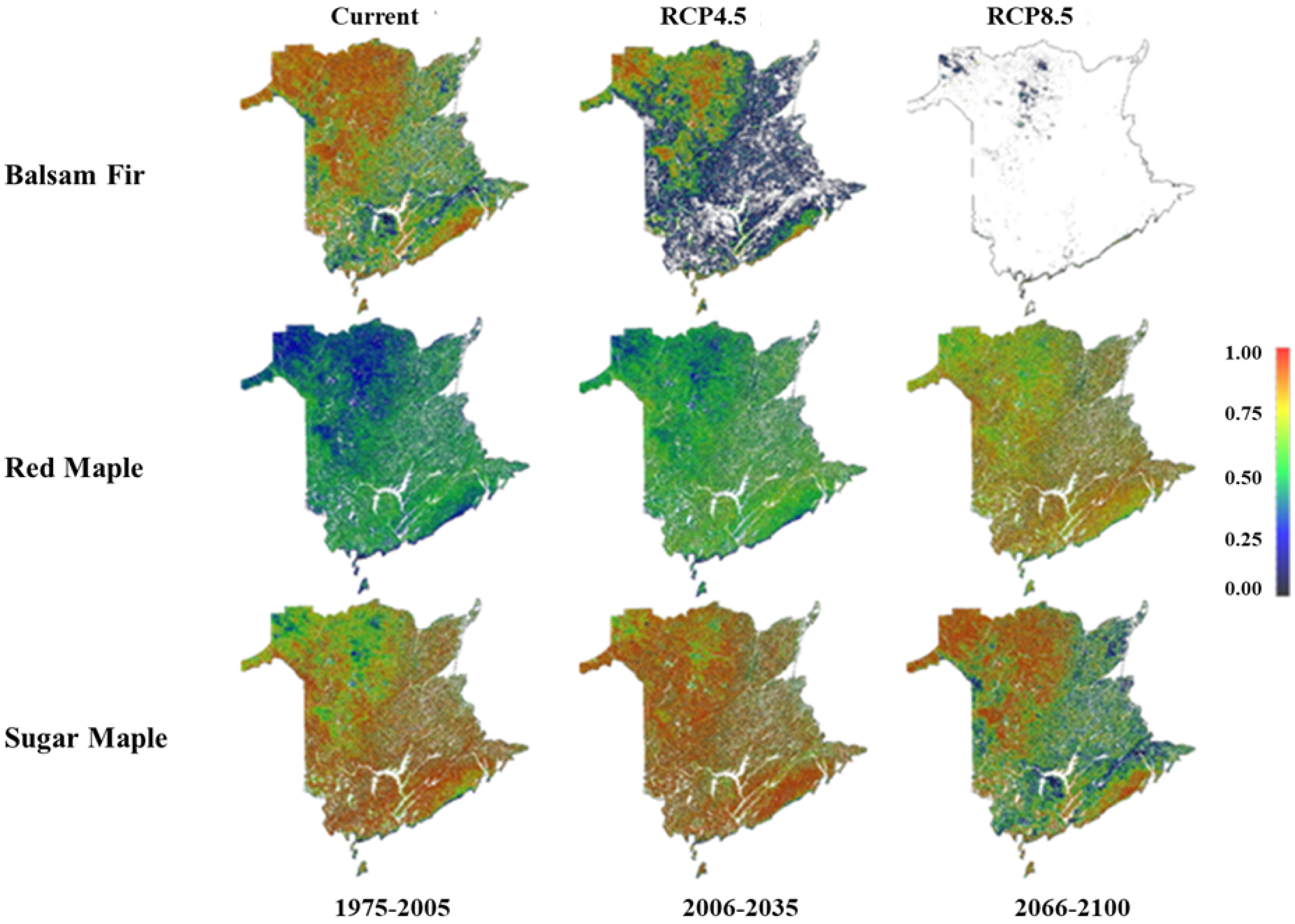Projected Wind Impact on Abies balsamea (Balsam fir)-Dominated Stands in New Brunswick (Canada) Based on Remote Sensing and Regional Modelling of Climate and Tree Species Distribution
Abstract
:1. Introduction
2. Materials and Methods
2.1. Study Areas
2.2. Surface Description and Development
- High-resolution, four-band digital orthophotos taken after the passage of extratropical cyclone Arthur in detection of windthrow- and non-windthrow-affected forests;
- Spatially explicit reconstructions of wind fields during the peak of cyclone Arthur obtained with a computational fluid dynamics model (CFD) and input wind data (speed and direction) from two Environment and Climate Change Canada (ECCC) weather stations in southwestern NB (i.e., Fredericton Airport and St. Stephen weather stations; Figure 1);
- Selected forest-state variables from a suite of GIS-thematic variables of stand type, structure, soil depth and texture and other stand indicators (Table 1), and environmental site variables of digital elevation model (DEM)-derived estimates of slope, height above nearest drainage point [17,18] and modelled relative soil water content.
2.3.1. Digital Elevation Model
2.3.2. Wind Speed and Direction
2.3.3. Soil Water Content
2.3.4. Windthrow Detection
2.3.5. Windthrow Function Development
2.3.6. Projected Future Climates
2.3.7. Projected Species Shifts
3. Results and Discussion
3.1. Principal Component Analysis
3.2. Windthrow Function Development
3.3. Windthrow Function Validation
3.4. Projected Windthrow under Current and Future Climatic Conditions
4. Conclusions
Author Contributions
Funding
Acknowledgments
Conflicts of Interest
Appendix A. (Follows below, in Landscape Format)
| Species | p(ϕk)1,2 | δ23 | δ3 | δ4 |
|---|---|---|---|---|
| Balsam Fir | ||||
| Black Spruce | ||||
| Eastern White Cedar | ||||
| Red Maple | ||||
| Sugar Maple |
| Tree Species | Accuracy 1 (%) | ηcrit (m s−1) | Peak Wind Gust Associated with ηcrit 2 (m s−1) | Threshold (unitless) | Number of Observations |
|---|---|---|---|---|---|
| Balsam Fir | 94.6 | 5.8 | 8.8 | 0.03 | 518 |
| Black Spruce | ~100 | 6.4 | 9.6 | 0.49 | 129 |
| Eastern White Cedar | 93.4 | 5.8 | 8.8 | 0.02 | 332 |
| Red Maple | 96.3 | 7.0 | 10.3 | 0.02 | 243 |
| Sugar Maple | ~100 | 9.5 | 13.5 | 0.50 | 112 |
References
- Ulanova, N.G. The effects of windthrow on forests at different spatial scales: A review. For. Ecol. Manag. 2000, 135, 157–167. [Google Scholar] [CrossRef]
- Klaus, M.; Holsten, A.; Hostert, P.; Kropp, J.P. Integrated methodology to assess windthrow impacts on forest stands under climate change. For. Ecol. Manag. 2011, 261, 1799–1810. [Google Scholar] [CrossRef]
- Jackson, T.; Shenkin, A.; Kalyan, B.; Zionts, J.; Calders, K.; Origo, N.; Disney, M.; Burt, A.; Raumonen, P.; Malhi, Y. A new architectural perspective on wind damage in a natural forest. Front. For. Global Chang. 2019, 1, 13. [Google Scholar]
- Quine, C.; Coutts, M.; Gardiner, B.; Pyatt, G. Forests and wind: Management to minimise damage. For. Comm. Bull 1995, 114, 24. [Google Scholar]
- Repap New Brunswick. The Christmas Mountains Blowdown; Miramichi, N.B., Ed.; Repap Training Centre: Miramichi, NB, Canada, 1995. [Google Scholar]
- Mitchell, S.J. Wind as a natural disturbance agent in forests: A synthesis. Forestry 2013, 86, 147–157. [Google Scholar] [CrossRef] [Green Version]
- Anyomi, K.A.; Mitchell, S.J.; Ruel, J.-C. Windthrow modelling in old-growth and multi-layered boreal forests. Ecol. Model. 2016, 327, 105–114. [Google Scholar] [CrossRef]
- Mokroš, M.; Výboštok, J.; Merganič, J.; Hollaus, M.; Barton, I.; Koreň, M.; Tomaštík, J.; Čerňava, J. Early stage forest windthrow estimation based on unmanned aircraft system imagery. Forests 2017, 8, 306. [Google Scholar] [CrossRef] [Green Version]
- Meng, J.; Bai, Y.; Ma, W. A management tool for reducing the potential risk of windthrow for coastal Casuarina equisetifolia L. stands on Hainan Island, China. Euro. J. For. Res. 2017, 136, 543–554. [Google Scholar] [CrossRef]
- Coates, K.D.; Burton, P.J. A gap-based approach for development of silvicultural systems to address ecosystem management objectives. For. Ecol. Manag. 1997, 99, 337–354. [Google Scholar] [CrossRef]
- Peringer, A.; Buttler, A.; Gillet, F.; Pătru-Stupariu, I.; Schulze, K.A.; Stupariu, M.-S.; Rosenthal, G. Disturbance-grazer-vegetation interactions maintain habitat diversity in mountain pasture-woodlands. Ecol. Model. 2017, 358, 301–310. [Google Scholar] [CrossRef]
- Anyomi, K.A.; Mitchell, S.J.; Perera, A.H.; Ruel, J.-C. Windthrow dynamics in Boreal Ontario: A simulation of the vulnerability of several stand types across a range of wind speeds. Forests 2017, 8, 233. [Google Scholar] [CrossRef] [Green Version]
- Raymond, P.; Bédard, S. The irregular shelterwood system as an alternative to clearcutting to achieve compositional and structural objectives in temperate mixedwood stands. For. Ecol. Manag. 2017, 398, 91–100. [Google Scholar] [CrossRef]
- Wilson, E.A.; Maclean, D.A. Windthrow and growth response following a spruce budworm inspired, variable retention harvest in New Brunswick, Canada. Can. J. For. Res. 2015, 45, 659–666. [Google Scholar] [CrossRef]
- Jaloviar, P.; Saniga, M.; Kucbel, S.; Pittner, J.; Vencurik, J.; Dovciak, M. Seven decades of change in a European old-growth forest following a stand-replacing wind disturbance: A long-term case study. For. Ecol. Manag. 2017, 399, 197–205. [Google Scholar] [CrossRef]
- Environment and Climate Change Canada, Historical Data. Available online: https://climate.weather.gc.ca/ (accessed on 12 March 2020).
- Rennó, C.D.; Nobre, A.D.; Cuartas, L.A.; Soares, J.V.; Hodnett, M.G.; Tomasella, J. HAND, a new terrain descriptor using SRTM-DEM: Mapping terra-firme rainforest environments in Amazonia. Remote Sens. Environ. 2008, 112, 3469–3481. [Google Scholar] [CrossRef]
- Murphy, P.N.C.; Ogilvie, J.; Meng, F.R.; White, B.; Bhatti, J.S.; Arp, P.A. Modelling and mapping topographic variations in forest soils at high resolution: A case study. Ecol. Model. 2011, 222, 2314–2332. [Google Scholar] [CrossRef]
- Bourque, C.P.-A.; Gullison, J.J. A technique to predict hourly potential solar radiation and temperature for a mostly unmonitored area in the Cape Breton Highlands. Can. J. Soil. Sci. 1998, 78, 409–420. [Google Scholar] [CrossRef]
- Bourque, C.P.-A.; Meng, F.-R.; Gullison, J.J.; Bridgland, J. Biophysical and potential vegetation growth surfaces for a small watershed in northern Cape Breton Island, Nova Scotia, Canada. Can. J. For. Res. 2000, 30, 1179–1195. [Google Scholar] [CrossRef]
- Fahmy, S.H.; Hann, S.W.R.; Jiao, Y. Soils of New Brunswick: The Second Approximation; Agriculture and Agri-food Canada Report, Technical Publication Number, NBSWCC-PRC 2010-01; Eastern Canada Soil and Water Conservation Centre and Agriculture and Agri-food Canada: Moncton, NB, Canada, 2010; p. 87. [Google Scholar]
- Bourque, C.P.-A. Modelled Potential Tree Species Distribution for Current and Projected Future Climates for New Brunswick, Canada; Unpublished Report Prepared for the New Brunswick Department of Environment and Local Government: Fredericton, NB, Canada, 2015; p. 40.
- Scinocca, J.F.; Kharin, V.V.; Jiao, Y.; Qian, M.W.; Lazare, M.; Solheim, L.; Flato, G.M.; Biner, S.; Desgagne, M.; Dugas, B. Coordinated global and regional climate modeling. J. Clim. 2016, 29, 17–35. [Google Scholar] [CrossRef]
- Arora, V.K.; Scinocca, J.F.; Boer, G.J.; Christian, J.R.; Denman, K.L.; Flato, G.M.; Kharin, V.V.; Lee, W.G.; Merryfield, W.J. Carbon emission limits required to satisfy future representative concentration pathways of greenhouse gases. Geophys. Res. Lett. 2011, 38, L05805. [Google Scholar] [CrossRef]
- Van Vuuren, D.P.; Edmonds, J.; Kainuma, M.; Riahi, K.; Thomson, A.; Hibbard, K.; Hurtt, G.C.; Kram, T.; Krey, V.; Lamarque, J.-F.; et al. The representative concentration pathways: An overview. Clim. Chang. 2011, 109, 5–31. [Google Scholar] [CrossRef]
- Lopes, A.M.G. WindStation—A software for the simulation of atmospheric flows over complex topography. Environ. Modell. Softw. 2003, 18, 81–96. [Google Scholar] [CrossRef]
- Franklin, J.L.; Black, M.L.; Valde, K. GPS dropwindsonde wind profiles in hurricanes and their operational implications. Weather Forecast. 2002, 18, 32–44. [Google Scholar] [CrossRef]
- Tyner, B.; Aiyyer, A.; Blaes, J.L.; Hawkins, D.R. An examination of wind decay, sustained wind speed forecasts, and gust factors for recent tropical cyclones in the mid-Atlantic region of the United States. Weather Forecast. 2015, 30, 153–176. [Google Scholar] [CrossRef]
- Blaes, J.L.; Hawkins, R.D. Improving Methodologies for Operational Forecasts of Winds and Wind Gusts during Tropical Cyclones. Available online: https://vlab.ncep.noaa.gov/documents/10157/137122/20160316.vlab.presentation.pdf/a78e0a31-0036-483c-8623-3d7f7d6a0e9f (accessed on 3 March 2020).
- Schietti, J.; Emilio, T.; Rennó, C.D.; Drucker, D.P.; Costa, F.R.C.; Nogueira, A.; Baccaro, F.B.; Figueiredo, F.; Castilho, C.V.; Kinupp, V.; et al. Vertical distance from drainage drives floristic composition changes in an Amazonian rainforest. Plant Ecol. Divers. 2014, 7, 241–253. [Google Scholar] [CrossRef]
- Moore, I.D.; Norton, T.W.; Williams, J.E. Modelling environmental heterogeneity in forested landscapes. J. Hydrol. 1993, 150, 717–747. [Google Scholar] [CrossRef]
- Gallant, J. Complex Wetness Index Calculations, WET Documentation Ver. 2.0.; Centre for Resource and Environmental Studies, Australian National University: Canberra, Australia, 1996. [Google Scholar]
- Planchon, O.; Darboux, F. A fast, simple and versatile algorithm to fill the depressions of digital elevation models. Catena 2001, 46, 159–176. [Google Scholar] [CrossRef]
- Conrad, O.; Bechtel, B.; Bock, M.; Dietrich, H.; Fischer, E.; Gerlitz, L.; Wehberg, J.; Wichmann, V.; Böhner, J. System for automated geoscientific analyses (SAGA) v. 2.1.4. Geosci. Model. Develop. 2015, 8, 1991–2007. [Google Scholar] [CrossRef] [Green Version]
- Priestley, C.H.B.; Taylor, R.J. On the assessment of surface heat flux and evaporation using large scale parameters. Mon. Weather Rev. 1972, 100, 81–92. [Google Scholar] [CrossRef]
- Schmidt, M.; Lipson, H. Distilling free-form natural laws from experimental data. Science 2009, 324, 81–85. [Google Scholar] [CrossRef]
- Cios, K.J.; Pedrycz, W.; Swiniarski, R.W.; Kurgan, L.A. Data Mining: A Knowledge Discovery Approach; Springer: New York, NY, USA, 2007; p. 606. [Google Scholar]
- Riahi, K.; Rao, S.; Krey, V.; Cho, C.; Chirkov, V.; Fischer, G.; Kindermann, G.; Nakicenovic, N.; Rafa, J.P. RCP 8.5—A scenario of comparatively high greenhouse gas emissions. Clim. Chang. 2011, 109, 33–57. [Google Scholar] [CrossRef] [Green Version]
- Ruel, J.C. Factors influencing windthrow in balsam fir forests: From landscape studies to individual tree studies. For. Ecol. Manag. 2000, 135, 169–178. [Google Scholar] [CrossRef]
- Steil, J.C.; Blinn, C.R.; Kolba, R. Foresters’ perceptions of windthrow dynamics in northern Minnesota riparian management zones. North J. Appl. For. 2009, 26, 76–82. [Google Scholar] [CrossRef] [Green Version]
- Burns, R.M.; Honkala, B.H. Silvics of North America: 1. Conifers; Agriculture Handbook 654; US Department of Agriculture, Forest Service: Washington, DC, USA, 1990; Volume 1, p. 675.
- Canham, C.D.; Papaik, M.J.; Latty, E.F. Interspecific variation in susceptibility to windthrow as a function of tree size and storm severity for northern temperate tree species. Can. J. For. Res. 2001, 31, 1–10. [Google Scholar] [CrossRef]
- Bourque, C.P.-A.; Cox, R.M.; Allen, D.J.; Arp, P.A.; Meng, F.-R. Spatial extent of winter thaw events in eastern North America: Historical weather records in relation to yellow birch decline. Global Chang. Biol. 2005, 11, 1477–1492. [Google Scholar] [CrossRef]
- Saad, C.; Boulanger, Y.; Beaudet, M.; Gachon, P.; Ruel, J.C.; Gauthier, S. Potential impact of climatic change on the risk of windthrow in eastern Canada’s forests. Clim. Chang. 2017, 143, 487–501. [Google Scholar] [CrossRef]
- Yin, X.; Arp, P.A. Predicting forest soil temperatures from monthly air temperature and precipitation records. Can. J. For. Res. 1993, 23, 2521–2536. [Google Scholar] [CrossRef]
- IPCC. Climate Change 2013: The Physical Science Basis. Contribution of Working Group I to the Fifth Assessment Report of the Intergovernmental Panel on Climate Change; Stocker, T.F., Qin, D., Plattner, G.-K., Tignor, M., Allen, S.K., Boschung, J., Nauels, A., Xia, Y., Bex, V., Midgley, P.M., Eds.; Cambridge University Press: Cambridge, UK; New York, NY, USA, 2013; p. 1535. [Google Scholar]










| Grouping | Variable | Significance | Data Source |
|---|---|---|---|
| Wind-related variable | WNDSPD (3) | Wind speed (in m s−1); meteorological agent needed for windthrow | CFD-calculations based on input data relevant to the wind event |
| Forest-state and tree-related variables | TREEFORM | Relates to the sail area of the crown; grouped according to dominant stand type, i.e., hardwood or softwood (1 or 2) | GIS-thematic forest data, based on dominant first species code (L1S1 1) |
| DEVS | Dominant tree layer development stage class (1–6) | GIS-thematic forest data (L1DS 1) | |
| FRAC | Dominant tree layer first species % ratio (2–10) | GIS-thematic forest data (L1PR1 1) | |
| CC | Dominant tree layer crown closure code (1–5) | GIS-thematic forest data (L1CC 1) | |
| DC | Dominant tree layer density class (1–5) | GIS-thematic forest data (L1DC 1) | |
| SC | Dominant tree layer size class (1–3) | GIS-thematic forest data (L1SC 1) | |
| Terrain- and soil moisture-related variables | SLP (3) | Stand slope (in degrees); windthrow on slopes varies depending on the prevailing airflow and secondary air circulation | DEM-based calculation, based on finite differencing |
| SWC (3) | Stand relative soil water content (unitless); high soil water content tends to constrain root development and, as a result, soils of high SWC can encourage windthrow | DEM-based water-budget calculation with LanDSET 2 | |
| HNDP (3) | Terrain height above nearest drainage point in metres; functions similar to SWC in defining windthrow especially for wet areas in the landscape | DEM-based height difference with minimising-distance function to locate nearest drainage point | |
| Soil-related variables | SFERT | Soil fertility class (1–4); potentially defines growing potential of the soil and species wind firmness | GIS-thematic soil data, derived from soil parent material nutrient content and degree of weatherability |
| SDEPTH | Depth to contrasting layer (1–4); shallow soils function to restrict vertical root growth and reduces the anchoring potential of the soil | GIS-thematic soil data 3 | |
| CONTLYR | Contrasting layer description (1–7) | GIS-thematic soil data 3 | |
| STEXT | Soil texture class (1–3); addresses mechanical and water-drainage properties of the soil, i.e., anchoring potential | GIS-thematic soil data 3 | |
| SDRAIN | Soil drainage class (1–7); a field indicator of soil drainage taking into account soil texture and topographic position | GIS-thematic soil data 3 |
| Variable 1 | PC 1 (14.2%) | PC 2 (13.5%) | PC 3 (8.8%) | PC 4 (11.7%) | PC 5 (7.7%) | PC 6 (8.4%) | PC 7 (8.0%) | PC 8 (6.7%) |
|---|---|---|---|---|---|---|---|---|
| WNDSPD_MIN | 0.026 | 0.954 | −0.039 | 0.068 | −0.039 | 0.021 | −0.112 | 0.102 |
| WNDSPD_MAX | 0.019 | 0.940 | −0.022 | 0.111 | −0.051 | −0.059 | 0.174 | −0.144 |
| WNDSPD_MEAN | 0.024 | 0.981 | −0.038 | 0.097 | −0.043 | −0.033 | 0.052 | −0.037 |
| TREEFORM | −0.119 | −0.061 | 0.078 | 0.073 | 0.901 | 0.006 | −0.047 | 0.072 |
| DEVS | −0.025 | 0.023 | 0.283 | 0.031 | −0.843 | 0.137 | 0.024 | −0.022 |
| FRAC | 0.114 | −0.009 | 0.010 | −0.054 | 0.430 | 0.194 | 0.088 | −0.077 |
| CC | −0.143 | 0.096 | −0.805 | 0.004 | −0.040 | −0.132 | 0.039 | 0.125 |
| DC | −0.054 | 0.023 | −0.931 | −0.063 | 0.028 | 0.002 | −0.015 | 0.005 |
| SC | −0.208 | 0.034 | 0.644 | 0.021 | −0.179 | −0.135 | 0.056 | 0.166 |
| SLP_MIN | 0.209 | −0.040 | 0.002 | −0.011 | 0.005 | 0.049 | 0.106 | 0.912 |
| SLP_MAX | 0.142 | 0.033 | 0.015 | 0.017 | 0.017 | −0.172 | 0.937 | −0.047 |
| SLP_MEANb | 0.285 | 0.026 | 0.014 | 0.003 | 0.024 | −0.099 | 0.7662 | 0.5252 |
| SWC_MIN | −0.190 | −0.111 | 0.008 | 0.014 | 0.016 | 0.798 | −0.340 | 0.216 |
| SWC_MAX | −0.520 | 0.026 | −0.026 | 0.151 | 0.050 | 0.541 | 0.158 | −0.451 |
| SWC_MEAN | −0.413 | −0.060 | 0.007 | 0.097 | 0.058 | 0.836 | −0.116 | −0.122 |
| HNDP_MIN | 0.880 | 0.071 | −0.025 | −0.082 | 0.031 | −0.085 | −0.004 | 0.193 |
| HNDP_MAX | 0.853 | −0.083 | 0.049 | −0.011 | 0.018 | −0.219 | 0.290 | −0.003 |
| HNDP_MEAN | 0.929 | −0.010 | 0.009 | −0.048 | 0.022 | −0.178 | 0.168 | 0.102 |
| SFERT | 0.334 | 0.508 | −0.003 | −0.438 | −0.075 | 0.111 | 0.095 | −0.074 |
| SDEPTH | −0.075 | 0.000 | −0.013 | −0.867 | 0.089 | −0.079 | −0.008 | 0.088 |
| CONTLYR | 0.078 | −0.185 | 0.026 | −0.9223 | 0.039 | −0.022 | 0.040 | 0.042 |
| STEXT | 0.238 | −0.064 | −0.066 | −0.815 | −0.033 | 0.070 | 0.034 | −0.081 |
| SDRAIN | 0.104 | 0.116 | 0.049 | 0.396 | 0.083 | 0.249 | 0.174 | −0.000 |
© 2020 by the authors. Licensee MDPI, Basel, Switzerland. This article is an open access article distributed under the terms and conditions of the Creative Commons Attribution (CC BY) license (http://creativecommons.org/licenses/by/4.0/).
Share and Cite
Bourque, C.P.-A.; Gachon, P.; MacLellan, B.R.; MacLellan, J.I. Projected Wind Impact on Abies balsamea (Balsam fir)-Dominated Stands in New Brunswick (Canada) Based on Remote Sensing and Regional Modelling of Climate and Tree Species Distribution. Remote Sens. 2020, 12, 1177. https://doi.org/10.3390/rs12071177
Bourque CP-A, Gachon P, MacLellan BR, MacLellan JI. Projected Wind Impact on Abies balsamea (Balsam fir)-Dominated Stands in New Brunswick (Canada) Based on Remote Sensing and Regional Modelling of Climate and Tree Species Distribution. Remote Sensing. 2020; 12(7):1177. https://doi.org/10.3390/rs12071177
Chicago/Turabian StyleBourque, Charles P.-A., Philippe Gachon, Benjamin R. MacLellan, and James I. MacLellan. 2020. "Projected Wind Impact on Abies balsamea (Balsam fir)-Dominated Stands in New Brunswick (Canada) Based on Remote Sensing and Regional Modelling of Climate and Tree Species Distribution" Remote Sensing 12, no. 7: 1177. https://doi.org/10.3390/rs12071177





